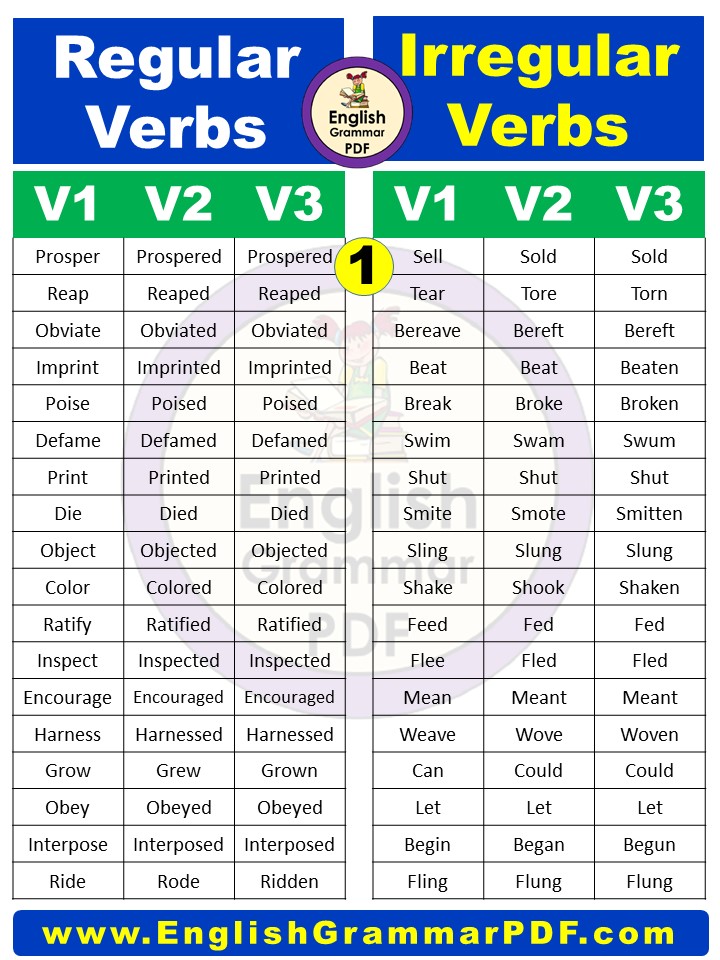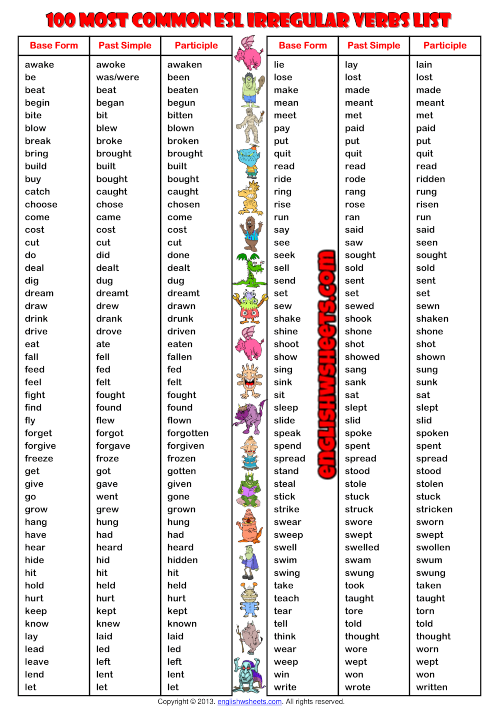

One easy way to improve your English is to really learn the Irregular verb forms in the Past Simple and the Past Perfect.
English irregular verbs list full#
All irregular verb forms are given in full at the main dictionary entry.The exercises and table below have the 100 most common verbs in the past which you really need to learn at a B1 or Intermediate level of English. If you aren’t sure how a verb behaves, it’s best to look it up. There are many more irregular verbs in English than those listed here. Note that sometimes the spelling doesn’t change but the pronunciation does (e.g. Irregular verbs is used for writing, reading, speaking and listening. You need to memorize all the irregular verbs on the lit or at least the most common ones. Here are the forms of some of the most common irregular verbs: Verb The irregular verbs list is very important to be able to understand English. There are many irregular verbs that don’t follow the normal rules.

hurry/hurrying, clarify/clarifying).įor more detail, see Verb tenses: adding-ed-and-ing. If the basic form ends in y just add - ing (e.g. If the verb ends in e, drop the e before adding - ing (e.g. If the basic form of the verb ends in a consonant or a vowel other than e, add the ending - ing (e.g. To make the present participle of regular verbs: To form the past participle of regular verbs, follow the same rules as for the past simple tense above. play/played, enjoy/enjoyed).įor more detail, see Verb tenses: adding-ed-and-ing.
English irregular verbs list plus#
But if the verb ends in a vowel plus -y, just add -ed (e.g. Likewise, irregular verbs that don’t change at all, like bet or spread, are also weak. If the verb ends in a consonant plus -y, change the y to an i before adding -ed (e.g. One of the most common examples of an irregular weak verb is sleep: Although sleep has its own special past tense and past participle forms (slept), it still keeps e as the main vowel, making it a weak verb. seem/seemed, laugh/laughed, look/looked).įor verbs that end in -e, add -d (e.g. New verbs (including loans from other languages, and nouns employed as verbs, such as to facebook) follow the regular inflection, unless they are compound formations from an existing irregular verb (such as housesit, from sit). If the basic form of the verb ends in a consonant or a vowel other than e, add the letters - ed to the end (e.g. The irregular verbs include many of the most common verbs: the dozen most frequently used English verbs are all irregular. Past tense formationįorming the past simple tense of regular verbs is mostly straightforward, and you use the same form for the first, second, and third persons, singular and plural: But if the verb ends in a vowel plus -y, just add -s (e.g. If the verb ends in a consonant plus - y, change the y to an i before adding - es (e.g. kiss/kisses, fizz/fizzes, punch/punches, wash/washes, mix/mixes). Verbs that end with -s, - z, -ch, - sh, and -x add -es (e.g. Verbs that end with a vowel other than e add - es (e.g. Most verbs just add - s to the basic form (e.g. In the present simple tense, the basic form of a regular verb only changes in the 3 rd person singular, as follows: Many English verbs are regular, which means that they form their different tenses according to an established pattern.

This section deals with inflecting verbs to show tenses and participles, and is divided into two main sections: first person, second person, or third person). In the context of verbs, we use the term inflection to talk about the process of changing a verb form to show tense, mood, number (i.e. What's The Difference Between Regular And Irregular Verbs?


 0 kommentar(er)
0 kommentar(er)
